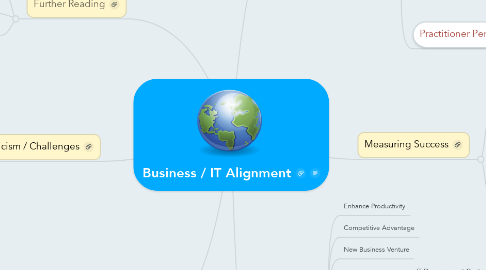
1. OBU Global MBA Organizational Architecture Leadership Engagement Group 1
2. Alignment Models / Approaches
2.1. Information System Strategic Alignment Model (ISSAM)
2.2. Luftman's Maturity Model (SAMM)
2.3. Strategic Alignment Model (SAM)
2.4. TOGAF
2.5. Others
2.5.1. Earl's Multiple Methodology
2.5.2. MIT90s Framework
2.5.3. Generic Framework
2.5.4. United Framework
2.5.5. Integrated Architecture Framework (IAF)
3. Criticism / Challenges
3.1. Chan and Reich, 2007
3.2. Shpilberg et al., 2007
3.3. Hinssen P., 2009
3.4. Neil & Neil, 2005
4. Further Reading
4.1. Articles / Papers
4.2. Books
4.3. Websites
5. Benefits
5.1. Enhance Productivity
5.2. Competitive Advantage
5.3. New Business Venture
5.4. Cost Savings
5.4.1. IT Development Costs
5.4.2. IT Maintenance Costs
5.4.3. IT Software Costs
5.4.4. Staff Costs
5.5. Improved operational Efficiency
5.6. Organizational agility
5.7. Quality improvement
5.7.1. Supply Chains network
5.7.2. Product or Service
5.7.3. Operational managemnt
5.7.4. Staff performance
5.8. Improve risk control mechanisms
5.9. Improve communications and workflow
6. Conceptual Evolution
6.1. Academic Perspectives
6.1.1. Henderson & Venkatramnan (1989)
6.1.2. Reich & Benbasat (1996)
6.1.3. Porter (1996)
6.1.4. Ciborra (1997)
6.1.5. Luftman (2000)
6.1.6. Tallon et al. (2000)
6.1.7. Maes et al. (2000)
6.1.8. Smaczny (2001)
6.1.9. Avison et al. (2004)
6.1.10. Chan & Reich (2007)
6.2. Practitioner Perspectives
6.2.1. 2011 CIO Insight
6.2.2. Gilbert Silvius (2007)
6.2.3. Campbell et al. (2005)
6.2.4. Cisco Global IT Impact Survey
7. Measuring Success
7.1. Balance Scorecard
7.1.1. Financial
7.1.1.1. Financial Performance
7.1.2. Non-financial
7.1.2.1. Satisfaction
7.1.2.2. Efficiency
7.1.2.3. Knowledge and Innovation
7.2. Strategy Mapping
7.2.1. Financial
7.2.2. Customer
7.2.3. Internal Process
7.2.4. Organizational Capacity

